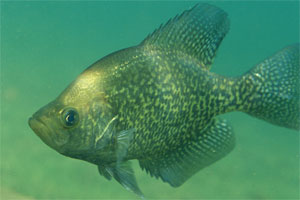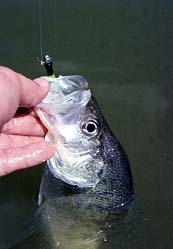
I do most of my crappie fishing in eastern Arkansas where clear waters are as rare as 5-pound crappie. I have no trouble catching crappie in the highly colored oxbow lakes I usually visit, but put me on a clear mountain reservoir, and I find it hard to get a nibble.
To be better prepared for my next clear-water experience, I consulted three experts on clear-water crappie fishing. I explained some problems I've encountered when fishing transparent water and asked how they catch fish in similar situations. The advice they offered should help any crappier score more consistently.
Finding Clear-Water Crappie
 |
| Clear water makes it easier for crappie to get spooked. Photo via wikipedia.org |
In stained or muddy water, crappie are usually in the shallows, holding tight against cover features like brush and stumps. In clear water, however, crappie spend more time in deep water, making them more difficult to find.
According to Al Ledbetter of Fayetteville, Ark., trolling is one way crappie anglers can deal with this problem. Ledbetter is retired and spends 175 to 200 days annually crappie fishing on several small clear-water lakes in northwest Arkansas's Ozark Mountains. Outside the spring spawning season, nearly all crappie he catches are taken by trolling.
"When crappie are spawning, I cast, because it's difficult to troll in shallow water without getting hung up," Ledbetter says. "The rest of the year, I do most of my fishing by trolling. With trolling, you can find fish faster and catch more of them. It's a great way to find crappie in clear water."
Ledbetter fishes from a bass boat, using a simple four-rod setup. "I have two fishing rod holders at the front of my boat, one on each side," says Ledbetter. "In those I use two 5-foot ultralight fishing rods. Back where the boat widens out, I have two more rod holders for a pair of 6-1/2-foot ultralight rods. I use 6-pound fishing line when fishing clear water, and I fish primarily with Roadrunner-type spinnerbaits I make myself. These are 1/16 ounce and have a plastic grub body with a triple-ripple tail. I usually put white-bodied lures with white heads on two lines, and yellow-bodied lures with red heads on two lines. Those colors seem to work best in clear water."
A sonar unit helps Ledbetter follow creek channels and other deep-water structure where clear-water crappie are likely to be. He uses an outboard motor in low gear to push the boat slowly through the area he's fishing.
"When using an active bait, you can move very slowly and the twisting tails and spinner will attract a crappie's attention," he says. "But in order to get your lure down to the depths where these fish are, you have to troll with a lot of line out. For instance, on one clear lake I fish, crappie are usually 12 to 15 feet deep along a creek channel. To get my lure down to them, I fish with at least 75 feet of line behind me. When I pass through a school of fish, my motor may spook them and cause them to scatter, but with that much line out, the crappie usually bunch back up by the time my lure reaches them. There are times I've had as many as three fish on four lines."
Crappie in the Salad
 |
| Because crappie see better in clear water, they move around more. That makes them challenging to locate. |
Brett Hobbs, a fisheries biologist with the Arkansas Game & Fish Commission, manages fish in several clear-water lakes near Hot Springs, including Lake Ouachita, the state's largest lake. His years as a biologist and crappie angler have taught him a great deal about clear-water crappie behavior.
"There are several things anglers should remember when fishing clear water," Hobbs says. "First, crappie will be deeper during sunny conditions. The best fishing is usually early and late in the day or when the sky is cloudy, because crappie are more active then, cruising and feeding in shallower water where they're easier for most anglers to catch.
"Fishermen should also remember that crappie see better in clear water, and bigger lines are likely to spook them. It's best to drop to 6- or 8-pound line or even smaller. You may also want to use green-tinted lines that are less visible in clear water."
Clear lakes offer good conditions for the growth of green aquatic plants that thrive in sunlight, and Hobbs says if beds of aquatic vegetation are present, anglers should investigate to see if crappie are hiding in the cool shade around the greenery.
"Vegetation grows to the deepest levels in the clearest portion of a lake," he says. "Crappie in these areas utilize the shade line along the weeds as the sun moves through the sky. If they can get beside a wall of weeds that's casting a shadow, they'll linger in the shadow and seize prey right outside of it. In Lake Ouachita, people fish beds of elodea and milfoil around mid-lake islands. They'll usually drift with the wind and fish jigs or spinners along the shady side of the weeds. Once they've caught a crappie, they try to keep their lure in the strike zone and continue along the vegetation line."
On another clear lake Hobbs manages, crappiers fish jigs using a special bobber rig. "The bobber keeps your bait in the strike zone," says Hobbs. "On most waters, fishermen use a brightly colored bobber so they can see it better. But that won't work in clear water where crappie can inspect everything you throw their way. So on this clear lake, anglers use a clear casting bubble for a float. A clear bubble is harder for crappie to see, and people who use this technique catch lots of nice fish."
The Value of Flexibility
When fishing clear water, it's important for a crappie angler to be flexible, willing to change fishing tactics as each situation dictates. So says W.T. Moore, an avid crappier from Mountain View, Ark.
"I fish several clear-water lakes in the Ozarks," says Moore. "To be successful, you have to be adaptable. For instance, you may go out thinking you'll catch crappie in man-made brushpiles. Crappie like to get in these brushpiles to get out of the sun. But when you get there, you may find you can't get a nibble. In clear water, crappie can see better so they tend to roam around more. If they're not biting around the brush piles, you have to be prepared to try different places or tactics until you start catching fish."
Being flexible doesn't mean abandoning the basic tenets of crappie fishing, Moore says. Regardless of where you fish, you'll still find crappie in cover on prominent structure.
"That applies in all types of water, from muddy to clear," he says. "The difference is, in clear water, crappie will be deeper. In an oxbow lake with stained water, you'll sometimes catch them 18 inches to two feet deep. But in clear lakes, you'll rarely find them in less than five feet of water unless they're spawning."
Night fishing is prominent on Moore's list of clear-water crappie tactics.
"Night is one of the best times to fish clear water," he says. "Use a topo map and sonar to locate bottom structure with brush on it. Then anchor your boat near the structure and throw out a floating crappie light. Soon, minnows will be swirling around in a white funnel below the light. The minnows attract crappie, but you still have to fish deep to catch them, maybe 15 to 20 feet. Use a heavier jig, up to 1/8 ounce, to get down to the fish quicker."
The best thing about night fishing is, it eliminates many problems that aggravate clear-water anglers. "Clear-water crappie are super shy," Moore says. "During the day, you have to make long casts to keep from spooking them. And you need to keep the sun in your face to keep your shadow off them. Sometimes that's hard to do.
"That's why I like night fishing," he continues. "You don't have to worry about these things. All you have to worry about is catching fish."
The next time you fish a crappie lake that's clear as gin, try some of the tips these experts have shared. They won't pay off every time, but they will pay off most of the time, and that means more crappie fishing fun for you.
- 23630 views

